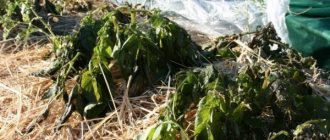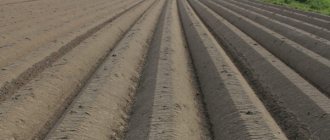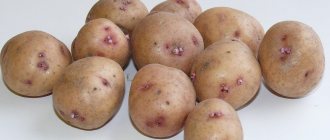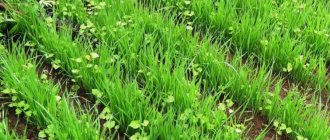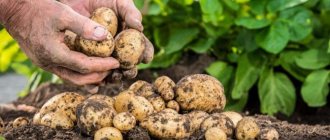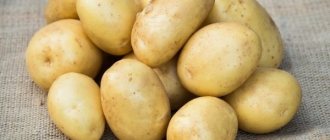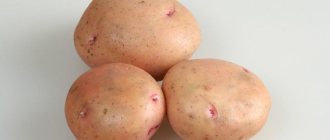Category: Siderates Reading time: 9 min · Views: 2,567
Many gardeners are trying to replace agrochemicals with natural soil fertilizers. In this case, green manure is used, which enriches the fertile layer with nutrients and improves the mechanical properties of the soil. What green manure for potatoes should you choose to enrich depleted soil with useful substances?
Selection of green manure
Potatoes can grow in one area for no more than four years, then the soil becomes depleted and ceases to supply the root crops with the necessary nutrients. In addition, an unkempt fertile layer of soil becomes a breeding ground for pathogenic bacteria that can destroy the crop. Refusal of chemicals can lead to many problems with the soil, so instead of them you can use plant components - green manure (green manure).
As potato green manure decomposes, it releases the required substances into the soil: nitrogen, potassium, phosphorus and other microelements. Also, thanks to green fertilizer, the soil is enriched with humus. However, care should be taken not to exaggerate the number of plants grown for humus, otherwise the green mass will begin to sour instead of decomposing.
No more than 2 kg of plant seeds are consumed per one hundred square meters of land.
Green manure plants:
- lupine;
- lentils;
- beans;
- sweet clover;
- sardella;
- peas;
- chickpeas;
- alfalfa;
- soybeans
The root system of green manure loosens the soil, and the green mass enriches it with nutrients and acts as mulch. For example, to enrich the soil with phosphorus and nitrogen, you need to plant leguminous plants.
Sunflower cannot be used as a green fertilizer. Firstly, it draws out many useful substances for its development. Secondly, its rough structure takes too long to decompose in the ground.
Other plants that enrich the soil with nutrition are:
- wheat;
- rapeseed;
- mustard;
- oats;
- rye;
- phacelia;
- rape.
They enrich the fertile layer with essential minerals, and also protect against weathering and dehydration. The above plants have a lower content of nitrogenous substances than legumes, but they also bring undoubted benefits to the soil and potatoes. And if these crops are planted in the fall, they will save the soil from freezing.
However, rye and wheat have the ability to attract wireworms into the soil, so it is advisable to exclude them from the list of green manures for potatoes.
Note! To increase potato yields, it is recommended to mix green manure with a high nitrogen content with others. The combination of nitrogen and minerals has the most beneficial effect on the nutritional value of the soil.
The choice of green manure is also based on the tubers’ need for sufficient air. Therefore, the soil must be breathable and loose. This can be ensured by properly selected plant crops.
Is it possible to replace green manure with humus? This option is also good for enriching the soil with humus and minerals, however, green fertilizer decomposes faster in the ground. Also, a disadvantage of fertilizing with humus is the larger amount of substrate added compared to green manure.
Disadvantages and mistakes in green manure
A layer of planted green mass that is too thick will not decompose in the soil, but will turn sour. Therefore, the height of the plants is controlled, plowing is carried out in a timely manner, preventing the crops from overgrowing and the seeds from ripening and waking up.
Sunflowers are not sown as green manure for potatoes. This plant depletes the top fertile layer of soil; massive sunflower stems slowly rot. Rye as green manure and wheat attract click beetles (wireworms), so these crops are used exclusively in the fall after harvesting potatoes.
See also
How to deal with black leg on potatoes?Read
The disadvantages of using green manure include:
- A clear positive effect does not appear immediately, but can last for several seasons.
- Financial costs for the purchase of seeds and agrotechnical measures.
- For each type of soil and crop, it is necessary to select certain types.
- Some of them cannot be planted on poor, unfertilized soils.
Green manure must be alternated, observing the rules of crop rotation. Otherwise, you will end up with a second monoculture, which will deplete the soil's nutritional resources.
The expected effect depends on the density of crops. Sparse planting will be useless, and too dense planting will “clog” the main crops. Planting and harvesting times are strictly observed and the green mass is not allowed to become coarse.
Methods of application
Green manure is used to improve the structure of the soil, so they can be planted twice a year - in the fall after harvesting the fruits and in the spring before planting crops in the beds. It is better to plant green manure for potatoes in the fall, but sometimes green manure is also grown in the spring.
The advantage of growing green mass in autumn is that the vegetation cover protects the ground from freezing.
In the spring, after the snow melts, the plants are not removed from the site until May. Sometimes green manure is not removed when planting tubers, as it can protect them from the negative effects of sunlight and spring frosts.
If you decide to mow the green manure before planting potatoes, then this should be done about a month before the start of work. At the same time, you need to make sure that the green manure does not turn into color, otherwise the process of decomposition in the ground will slow down.
But after harvesting, you need to plant leguminous plants, since even before the onset of frost they will have time to gain biomass.
Green fertilizer can be used in several ways:
- complete penetration into the soil;
- mowing method;
- cool way.
Complete embedding of green mass into the soil is carried out by digging up the area to a depth of 10 cm. The mowing method involves planting plants mown from another area into the soil. Removal method - only plant roots are used on the site, and the green mass is mowed and used for other purposes.
Using the exhaust method, you can enrich two areas with green fertilizer at once: the roots remain in one area, and the mowed mass is buried in another.
Green manures and their benefits for potatoes
Fast-growing plants, which are classified as green manure, are mowed or dug up with soil before planting potatoes or after harvesting.
Stimulate productivity
The roots of green manure preserved in the soil rot, enriching the soil with nutrients, especially nitrogen. Their advantages do not end there. The structure of the soil improves, the earth becomes looser, and is well saturated with oxygen. Plants contribute to the accumulation of moisture in the soil.
Protection from insects and weeds
Many green manures grow quickly, while suppressing the development of weeds. Since weed crops cannot become established, their spread is inhibited. Useful plants should not be planted in orderly rows, but scattered throughout the area.
Mustard perfectly fights wireworms and prevents the growth of weeds. And oilseed radish is even called a natural “agrokiller”, because the crop fights weeds (including creeping wheatgrass) so effectively.
It is important to take into account that the effect is felt when destroying annual weeds. To eliminate perennials, the gardener will have to use other methods.
Autumn work on the site
Green manure for potatoes is sown in the fall before the onset of cold weather, so that they have time to gain a thick green mass. Around mid-September, you can start sowing, having first dug up the ground well. In autumn, you can safely sow grain crops, as they are resistant to winter frosts.
Immediately after harvesting potatoes, you can plant green manure:
- peas;
- oats;
- mustard.
You can scatter the seeds onto the plowed soil and then level the surface with a rake. You can sow the seeds in shallow furrows and then cover them with soil. The top of the soil is covered with a small layer of compost for warmth. In the month of May, green manure is mowed and embedded in the soil, then potatoes are planted.
Alternate green manures on the site, do not plant the same crop every year.
Experienced gardeners advise not to mow green manure winter crops before frost. If you leave them until spring, you won’t have to dig up the soil to plant potatoes.
Spring work
Planting green manure in the spring under potatoes should be planned in April or early May. The criterion for choosing the right sowing time should be warm soil.
Before planting the tubers (14-15 days before), the green mass is mowed, and the soil with roots and plants is dug up to the depth of a shovel. The green mass quickly decomposes, releasing nutrients to the earth.
A big mistake is mowing green manure that has already produced seeds. Work must be carried out before the plants bloom vigorously.
What green manures are preferable for potatoes in spring? Gardeners believe that phacelia is a universal fertilizer for a rich harvest of root crops. This plant is sown immediately after the snow melts; before the potatoes are planted, they have time to gain green mass and at the same time structure the soil - make the soil loose. In addition, phacelia (like mustard) drives away wireworms from the area.
Too abundant green mass will not be able to completely rot in the ground and will begin to rot, so remove the excess.
At what depth should tubers be planted? Prepare holes 5-6 cm deep. Experienced gardeners plant potatoes together with mustard, as it protects against the appearance of weeds and loosens the soil well. When the mustard grows to the height of the potato tops, it needs to be trimmed. If this is not done, it will prevent the tops from developing. Cut mustard tops can be placed between rows or placed in compost.
Which ones to plant in spring and autumn
If you plant green manure for potatoes in the spring, then this should be done in April and no later than 2-3 weeks before planting the root crops. This condition is extremely important to observe, since in 3 weeks the plant must have time to rot and give the earth all the necessary nutritional components. Find out which weed killer is best in this material.
The process of planting green manure in beds.
When growing green manure in the spring, you need to make sure that they do not produce seeds. If this happens, the seeds will become a bait for the spread of weeds and will only cause harm. For spring sowing, you can choose the following green manures: fodder peas, mustard, phacelia and oats.
In the video - green manure for spring:
As for autumn planting of green manure, it is preferable to spring planting. This is due to the fact that during the winter the green manure will be able to release as many nutrients as possible to the soil, thereby increasing the potato yield.
Autumn planting of green manure will improve the soil structure, prevent the formation of weeds and repel pests.
In addition, in the spring, when the movement of melt water is observed, it is possible to prevent the earth from erosion, weathering and overheating by the sun's rays. Green manures such as alfalfa, vetch, peas, lupine and sweet clover are excellent for autumn planting.
Description of green manure crops
Legumes are considered the most useful, as they enrich the soil with nitrogenous substances and humus. But cruciferous plants, along with cereals, also contribute to enriching the soil. Let's consider their features.
Vetch (mouse peas)
This crop is characterized by an accelerated growing season and unpretentiousness to growing conditions. Mouse peas belong to the legume family, which means they accumulate large amounts of nitrogen between the root nodules. During the decomposition of roots in the ground, an active release of nitrogen occurs, without which potatoes cannot develop. The decomposition of the green mass of mouse peas enriches the soil with humus, greatly increasing its fertility.
Sweet clover
This crop is also distinguished by the rapid development of green mass, endurance and undemandingness to growing conditions. Sweet clover forms a powerful branched root system that goes to a depth of more than a meter. Thanks to the developed root system of sweet clover, the soil becomes loose and therefore does not need digging. In spring, the green mass is cut and placed between rows or planted in another area as a fall-off method of fertilization. Sweet clover belongs to the legume family.
Mustard
It is difficult to overestimate the importance of white mustard for feeding potatoes. Planting potatoes after green manure (mustard) gives a bountiful harvest. A culture with long roots attracts earthworms and creates favorable conditions for the formation of humus. Mustard has a phytosanitary effect on the soil, repelling pests and preserving potatoes from rot and other diseases. If there is a wireworm in your area, you can drive it away with white mustard.
Experienced gardeners mix mustard with mouse peas, achieving excellent results. To accelerate the decomposition of the green mass of a plant, biostimulants such as “Baikal” can be used. If you grow mustard together with potatoes, it will prevent weeds from developing.
Radish
This green manure crop also belongs to the cruciferous family, like mustard. Oilseed radish quickly grows, forming an abundant green mass. Weeds, including the ubiquitous wheatgrass, do not grow near this crop. Rarely has a phytosanitary effect on the soil, destroying rot and soil pests. Before sowing the seeds, the soil should be dug well, as radish does not like dense soil. After just a month, the tops can be cut off and the greens can be planted in the ground. The seed sowing rate is 300 grams per hundred square meters.
Rye
This cereal crop is an excellent winter green manure and soil sanitation plant. Rye completely destroys helminths and late blight, insects and other soil pests. The juicy green mass of rye quickly decomposes in the soil, releasing large amounts of phosphorus, nitrogen and potassium. A developed root system loosens the soil, making the fertile layer air- and water-permeable. Rye perfectly prepares the area for potatoes, creating the most favorable conditions for their development.
When is the best time to sow rye? Sowing is carried out immediately after harvesting, that is, at the end of August. In the spring, when the sprouts reach a height of 25-30 cm, the green manure is buried in the ground. After half a month, tubers can be planted.
Oats
This crop enriches the soil with nitrogen and potassium. A powerful root system loosens the soil, creating conditions for optimal water and air balance. It is recommended to sow oats on heavy soils that are unfavorable for the growth of root crops. To increase soil fertility, oats are mixed with mouse peas and fodder peas. Sometimes ammonium nitrate is also used when sowing. The green mass is embedded in the soil before the buds form.
Why do you need green manure for the garden in the fall?
Mustard will become your ally in the fight against nematodes, as well as a good predecessor for corn, potatoes and winter crops
If you are a supporter of organic farming, then you will certainly appreciate sowing green manure in the fall as the easiest and most inexpensive way to restore soil fertility, because green manure can do a lot:
- they loosen the soil;
- enrich the soil with useful substances, increasing its fertility;
- help protect the area from scab, various rots and even some insects;
- do not allow ubiquitous weeds to grow;
- mowed green manure is successfully used as a mulching material;
- frost-resistant green manure planted between beds of main vegetable crops can reduce damage from returning spring frosts;
- Winter green manures retain snow well, and therefore moisture on your site.
Vetch (mouse peas) helps loosen the soil, suppresses weeds and is a good precursor for beans, beets and carrots
Soil infested with fungus and pests
What to do if the site is not suitable for planting potatoes due to fungal and pest damage? In this case, green manure will also help. Gardeners treat the area with cruciferous plants - rapeseed, mustard, reps and radish. They free the soil from late blight, rot and potato scab. In addition to these diseases, cruciferous plants drive helminths and slugs away from the site.
If the soil is severely affected by late blight and pests, then the green manure is not mowed completely, but left between the rows - it will perform its phytosanitary functions until harvest.
Bottom line
Green manure for potatoes in the fall is an excellent environmentally friendly fertilizer. After such fertilizing, you can collect many times more harvest from the site. Tubers greatly deplete the soil, drawing out nutrients for their growth. Therefore, you cannot do without fertilizing - every year the harvest will decrease and the tubers will become smaller.
Green manure in the spring for potatoes prepares the soil well and creates favorable conditions for the development of tubers. When is the best time to plant green manure - in autumn or spring? Gardeners do not have a unanimous opinion on this matter. If you need to keep the ground from freezing, then you should plant winter crops.
